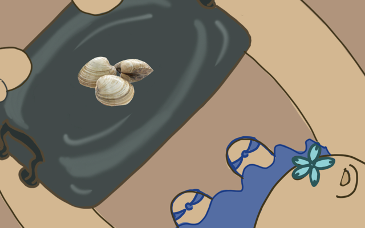Have you ever wondered where buttons come from? Maybe your favourite blouse or shirt has special buttons to complement its colour. Buttons can be made in different materials. Some buttons are made from wood which comes from trees, some are made from bamboo which is a plant, and others are plastic which is made from a group of different materials.
Buttons Made of Wood and Bamboo
Buttons made from Plastic


and then very unique looking and natural buttons are made from shells! That’s right, buttons can be made from sea shells!


Shell buttons are a very highly regarded type of button. This is because of their sheen, this refers to the glossy clean finish shell buttons have. Each shell is unique and so most buttons made from shells do not look exactly the same.

Let’s investigate where shells come from! If you’ve ever seen a snail, crab or a turtle then you have seen a shell before. A shell forms part of some animal’s skeleton, it is their exoskeleton because it is outside their body. A shell is basically their hard exterior! Shells are fascinating because they don’t deteriorate, this means if a shelled animal dies, their shell still remains. Even if they injure their shells, a new shell may replace the old one, but the old shell will still remain.

It is very possible you’ve seen beach shores littered with shells. This is where some old shells of animals end up. Shells on a beach are usually a very pretty sight as they are in different shapes, forms and colours!

Some people string shells into jewellery, and some use them as decorative pieces at home. All shells on the shores and at the seaside come from aquatic animals known as molluscs. Examples of molluscs at the seaside are snails, clams, oysters and mussels. Have you ever seen a mollusc?


Image of a clam shell. An example of a mollusc. –
Shells exist for different reasons, sometimes to protect the body of the animal or to help it dig into the sand.

They are made of calcium carbonate which is similar to what we have in our bones to make them strong and hard. Molluscs normally ingest salt and chemicals from the seawater throughout their lifetime, which helps them produce more calcium carbonate so their shells grow bigger and stronger! When these molluscs die, their bodies fall away from their shells and the shell washes up ashore.

Empty shells usually remain on the shore or around beaches and are normally picked up by birds who use them to make their nests.

Other animals like fish find empty shells underwater and use them as shelter or homes.

Humans also collect and use them for different reasons including making buttons! The button making business is a big industry in continents like Asia. Huge clothing stores purchase authentic shell buttons from there.

The best thing about shell buttons is they are nontoxic to the environment and natural.

Buttons are disc shaped and can be square, hexagonal or octagonal. The most common buttons are circular. Shells may not already be in the shape desired, some shells are curved, spiral and twisted and so button makers have to cut the shape out of the shell. This is done using a particular type of equipment named the tubular saw.

This saw cuts out the shape of the button required, and the cut pieces are called ‘blanks’. Some shells are very thick and so they have to be cut again to make thinner blanks. After cutting, the buttons have to be sorted through to find similar blanks. All the similar blanks are put together and then holes are drilled into them.

These will probably all go into one style of clothing. There are usually two to four small holes drilled into a button. These holes are used at later stages to attach the button to the clothing, using threads of different materials such as pima cotton, silk, cashmere or alpaca.

.


Image of sorting through buttons. –

Image of holes being drilled into buttons. –

Image of button being sewn onto clothing.
The buttons are then carved, they are carved close to the drilled holes. They can be carved with different designs. Some clothing brands elect to customise their buttons. If the factory customises a button, it uses laser equipment to customise it in split seconds! The beauty of shell buttons is their sheen, in factories the shell’s sheen is brought back to life with a mixture of water and acids. After that, they are sent to be polished, this process traditionally involves tossing the buttons in wax coated rice chaff to give it a brilliant shine.

Image of wood button being carved.
Buttons can be dyed to several colours. Shells already come in several colours and this is due to the animal’s diet because whatever the animals eat, can change the colour of their shell. At later stages of production, it may not be possible to get a lot of similar pieces in a natural colour, so some are dyed.

Image of dyed buttons
There are actually over 60,00 different types of buttons in the world today. At just one big factory, 2 – 3 million buttons are produced a day. Buttons are popular because people buy clothes because they need it. Some factories also make buttons from less natural materials, sometimes its because they want all their buttons to look the same unlike shell buttons or because they would like an affordable option.
The hallmark of a quality button is that it is easy to fasten and unfasten and it is has a blinding shine!









Leave a comment